ASA701: Auditing Standards Analysis and ABC Learning Centre Case Study
VerifiedAdded on 2020/03/28
|14
|3336
|128
Report
AI Summary
This report provides a comprehensive analysis of ASA701 auditing standards, focusing on their application in the wake of the financial crisis and using the collapse of ABC Learning Centre as a central case study. The report delves into the necessity of auditing according to ISA 701, defining key audit matters (KAM) and highlighting auditing issues that contributed to ABC Learning Centre's downfall, such as accounting principles, debt reporting, operating cash flow, and management failures. It then examines the development of ASA 701, including the factors that led to its implementation, such as the need for enhanced communication of KAM and the response to financial crises. The report also outlines key audit matters relevant to the ABC case and offers recommendations to improve auditing practices. By examining these aspects, the report aims to evaluate the relevance of auditing standards in preventing similar failures in the future.
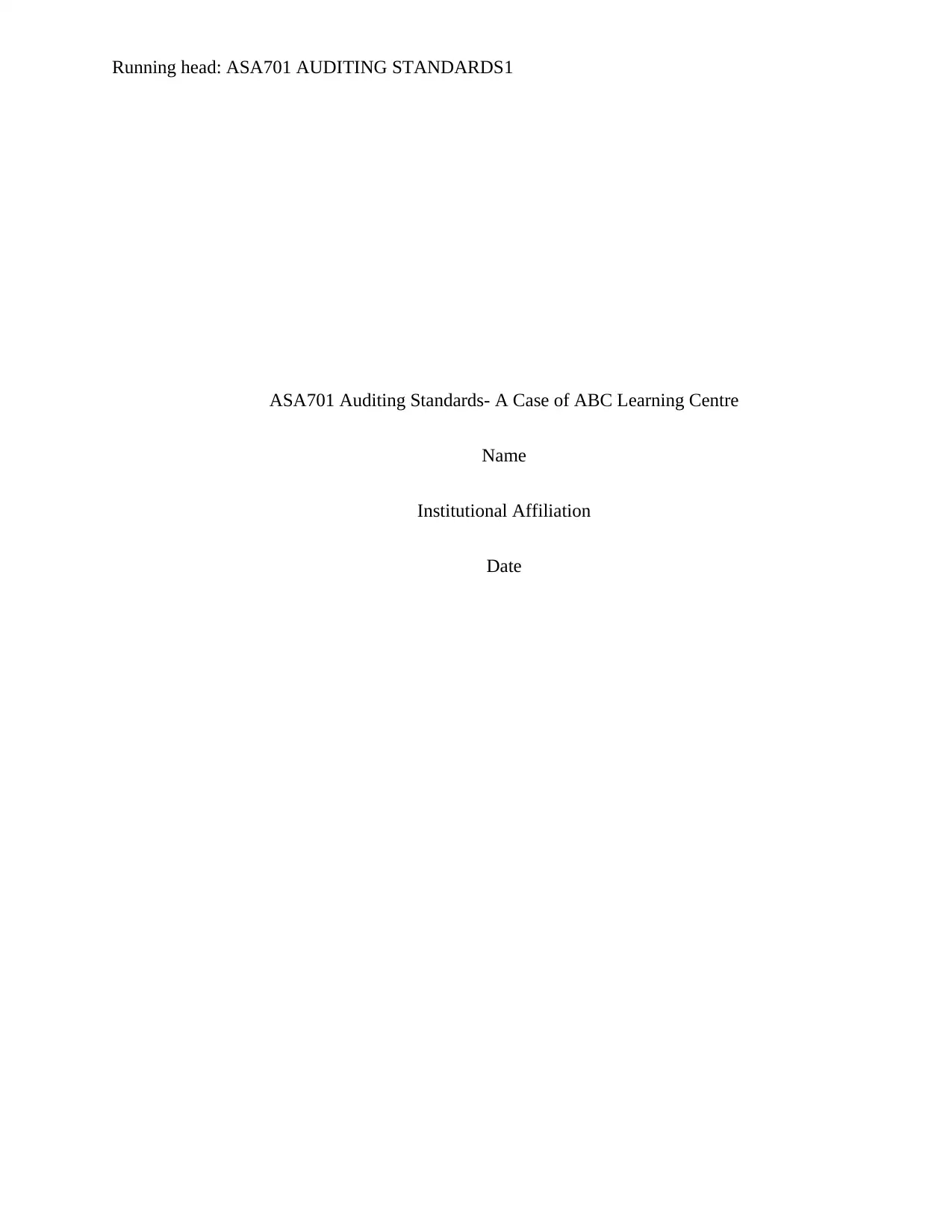
Running head: ASA701 AUDITING STANDARDS1
ASA701 Auditing Standards- A Case of ABC Learning Centre
Name
Institutional Affiliation
Date
ASA701 Auditing Standards- A Case of ABC Learning Centre
Name
Institutional Affiliation
Date
Paraphrase This Document
Need a fresh take? Get an instant paraphrase of this document with our AI Paraphraser
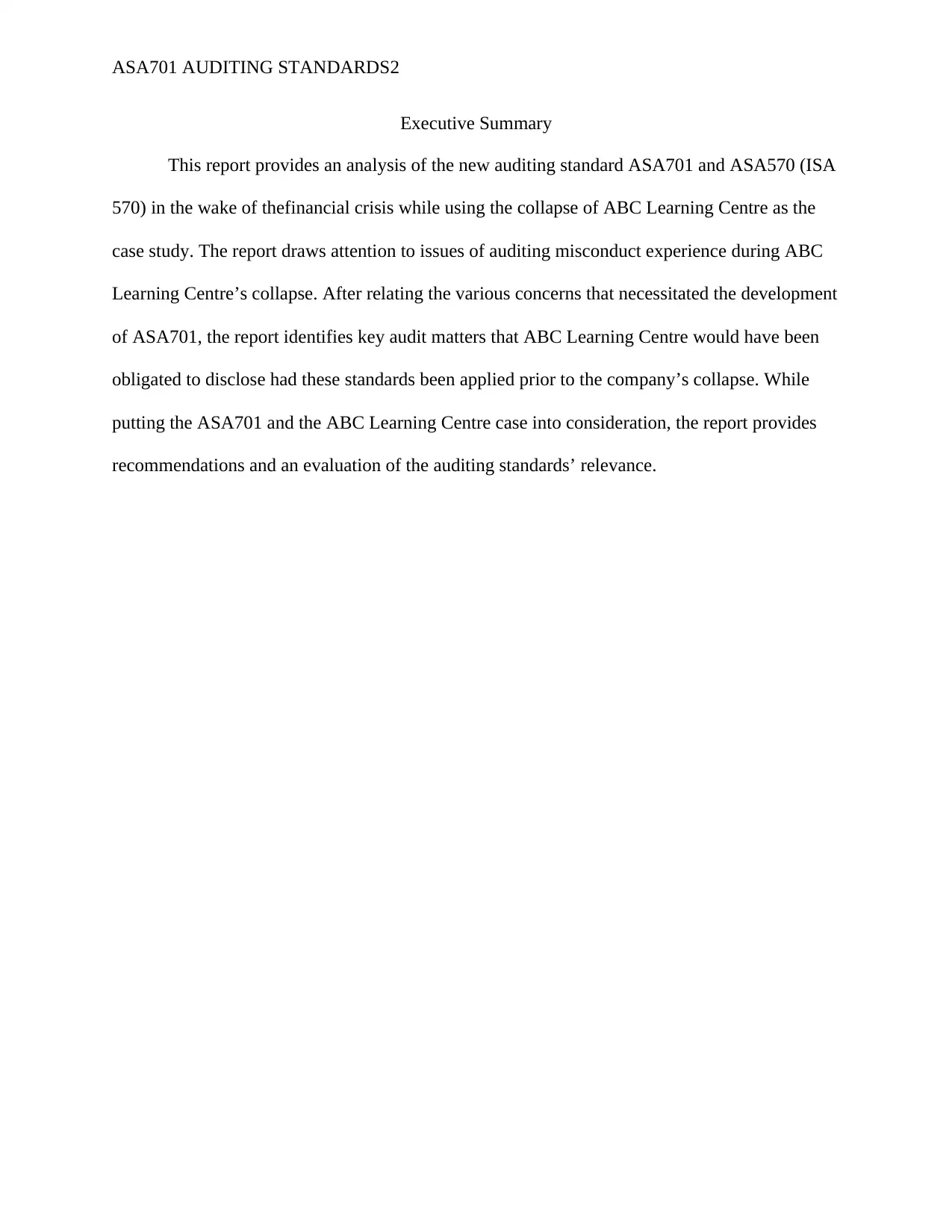
ASA701 AUDITING STANDARDS2
Executive Summary
This report provides an analysis of the new auditing standard ASA701 and ASA570 (ISA
570) in the wake of thefinancial crisis while using the collapse of ABC Learning Centre as the
case study. The report draws attention to issues of auditing misconduct experience during ABC
Learning Centre’s collapse. After relating the various concerns that necessitated the development
of ASA701, the report identifies key audit matters that ABC Learning Centre would have been
obligated to disclose had these standards been applied prior to the company’s collapse. While
putting the ASA701 and the ABC Learning Centre case into consideration, the report provides
recommendations and an evaluation of the auditing standards’ relevance.
Executive Summary
This report provides an analysis of the new auditing standard ASA701 and ASA570 (ISA
570) in the wake of thefinancial crisis while using the collapse of ABC Learning Centre as the
case study. The report draws attention to issues of auditing misconduct experience during ABC
Learning Centre’s collapse. After relating the various concerns that necessitated the development
of ASA701, the report identifies key audit matters that ABC Learning Centre would have been
obligated to disclose had these standards been applied prior to the company’s collapse. While
putting the ASA701 and the ABC Learning Centre case into consideration, the report provides
recommendations and an evaluation of the auditing standards’ relevance.
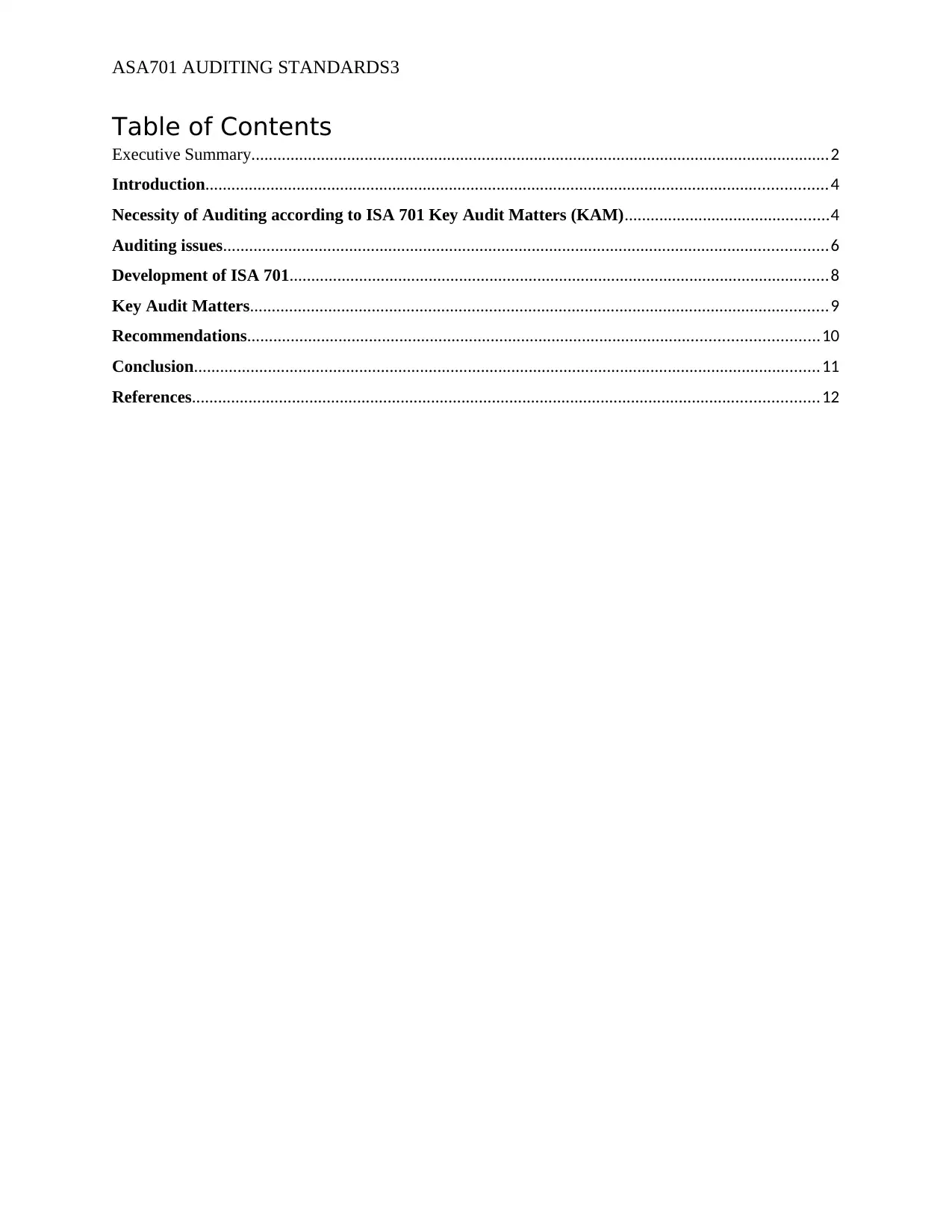
ASA701 AUDITING STANDARDS3
Table of Contents
Executive Summary.....................................................................................................................................2
Introduction...............................................................................................................................................4
Necessity of Auditing according to ISA 701 Key Audit Matters (KAM)...............................................4
Auditing issues...........................................................................................................................................6
Development of ISA 701............................................................................................................................8
Key Audit Matters.....................................................................................................................................9
Recommendations...................................................................................................................................10
Conclusion................................................................................................................................................11
References................................................................................................................................................12
Table of Contents
Executive Summary.....................................................................................................................................2
Introduction...............................................................................................................................................4
Necessity of Auditing according to ISA 701 Key Audit Matters (KAM)...............................................4
Auditing issues...........................................................................................................................................6
Development of ISA 701............................................................................................................................8
Key Audit Matters.....................................................................................................................................9
Recommendations...................................................................................................................................10
Conclusion................................................................................................................................................11
References................................................................................................................................................12
⊘ This is a preview!⊘
Do you want full access?
Subscribe today to unlock all pages.

Trusted by 1+ million students worldwide
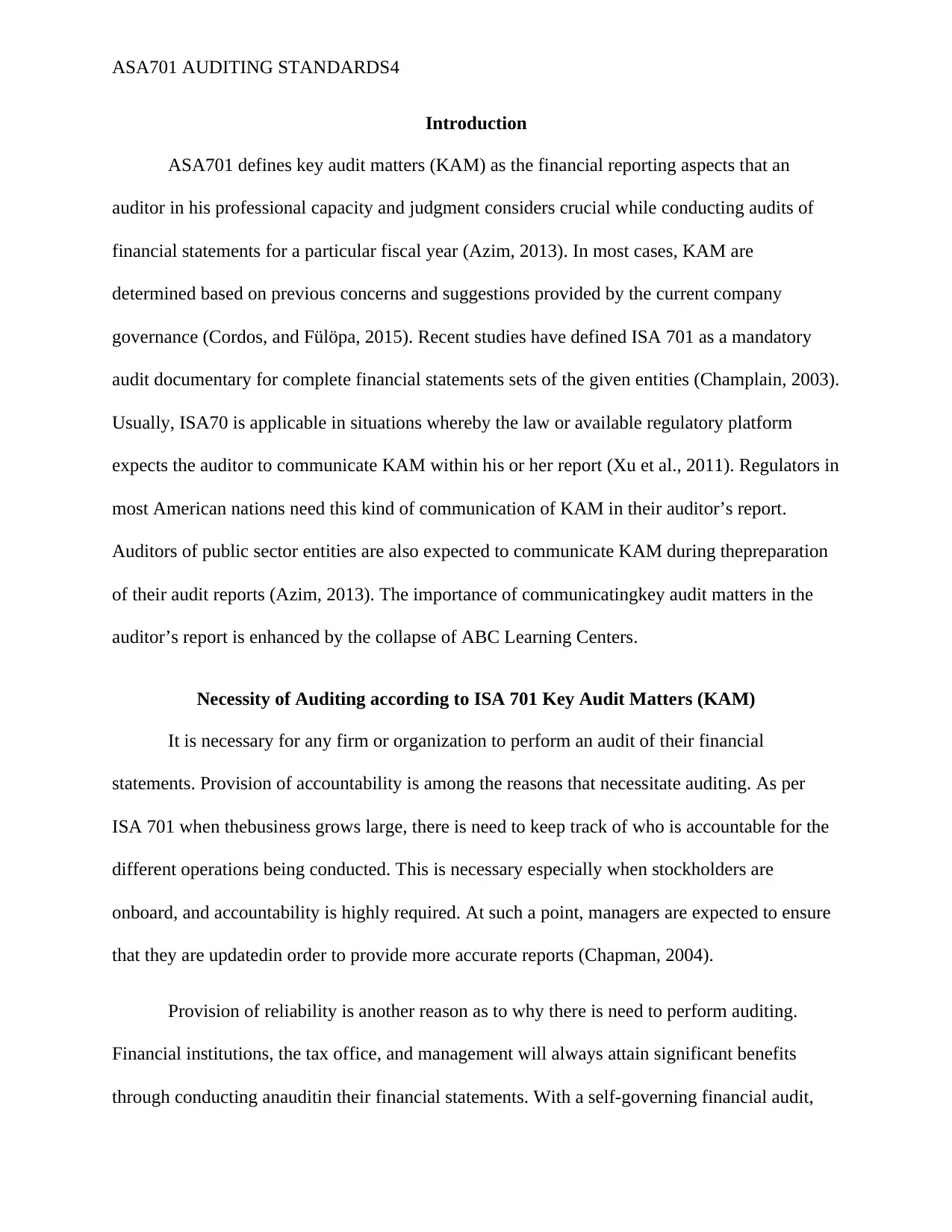
ASA701 AUDITING STANDARDS4
Introduction
ASA701 defines key audit matters (KAM) as the financial reporting aspects that an
auditor in his professional capacity and judgment considers crucial while conducting audits of
financial statements for a particular fiscal year (Azim, 2013). In most cases, KAM are
determined based on previous concerns and suggestions provided by the current company
governance (Cordos, and Fülöpa, 2015). Recent studies have defined ISA 701 as a mandatory
audit documentary for complete financial statements sets of the given entities (Champlain, 2003).
Usually, ISA70 is applicable in situations whereby the law or available regulatory platform
expects the auditor to communicate KAM within his or her report (Xu et al., 2011). Regulators in
most American nations need this kind of communication of KAM in their auditor’s report.
Auditors of public sector entities are also expected to communicate KAM during thepreparation
of their audit reports (Azim, 2013). The importance of communicatingkey audit matters in the
auditor’s report is enhanced by the collapse of ABC Learning Centers.
Necessity of Auditing according to ISA 701 Key Audit Matters (KAM)
It is necessary for any firm or organization to perform an audit of their financial
statements. Provision of accountability is among the reasons that necessitate auditing. As per
ISA 701 when thebusiness grows large, there is need to keep track of who is accountable for the
different operations being conducted. This is necessary especially when stockholders are
onboard, and accountability is highly required. At such a point, managers are expected to ensure
that they are updatedin order to provide more accurate reports (Chapman, 2004).
Provision of reliability is another reason as to why there is need to perform auditing.
Financial institutions, the tax office, and management will always attain significant benefits
through conducting anauditin their financial statements. With a self-governing financial audit,
Introduction
ASA701 defines key audit matters (KAM) as the financial reporting aspects that an
auditor in his professional capacity and judgment considers crucial while conducting audits of
financial statements for a particular fiscal year (Azim, 2013). In most cases, KAM are
determined based on previous concerns and suggestions provided by the current company
governance (Cordos, and Fülöpa, 2015). Recent studies have defined ISA 701 as a mandatory
audit documentary for complete financial statements sets of the given entities (Champlain, 2003).
Usually, ISA70 is applicable in situations whereby the law or available regulatory platform
expects the auditor to communicate KAM within his or her report (Xu et al., 2011). Regulators in
most American nations need this kind of communication of KAM in their auditor’s report.
Auditors of public sector entities are also expected to communicate KAM during thepreparation
of their audit reports (Azim, 2013). The importance of communicatingkey audit matters in the
auditor’s report is enhanced by the collapse of ABC Learning Centers.
Necessity of Auditing according to ISA 701 Key Audit Matters (KAM)
It is necessary for any firm or organization to perform an audit of their financial
statements. Provision of accountability is among the reasons that necessitate auditing. As per
ISA 701 when thebusiness grows large, there is need to keep track of who is accountable for the
different operations being conducted. This is necessary especially when stockholders are
onboard, and accountability is highly required. At such a point, managers are expected to ensure
that they are updatedin order to provide more accurate reports (Chapman, 2004).
Provision of reliability is another reason as to why there is need to perform auditing.
Financial institutions, the tax office, and management will always attain significant benefits
through conducting anauditin their financial statements. With a self-governing financial audit,
Paraphrase This Document
Need a fresh take? Get an instant paraphrase of this document with our AI Paraphraser
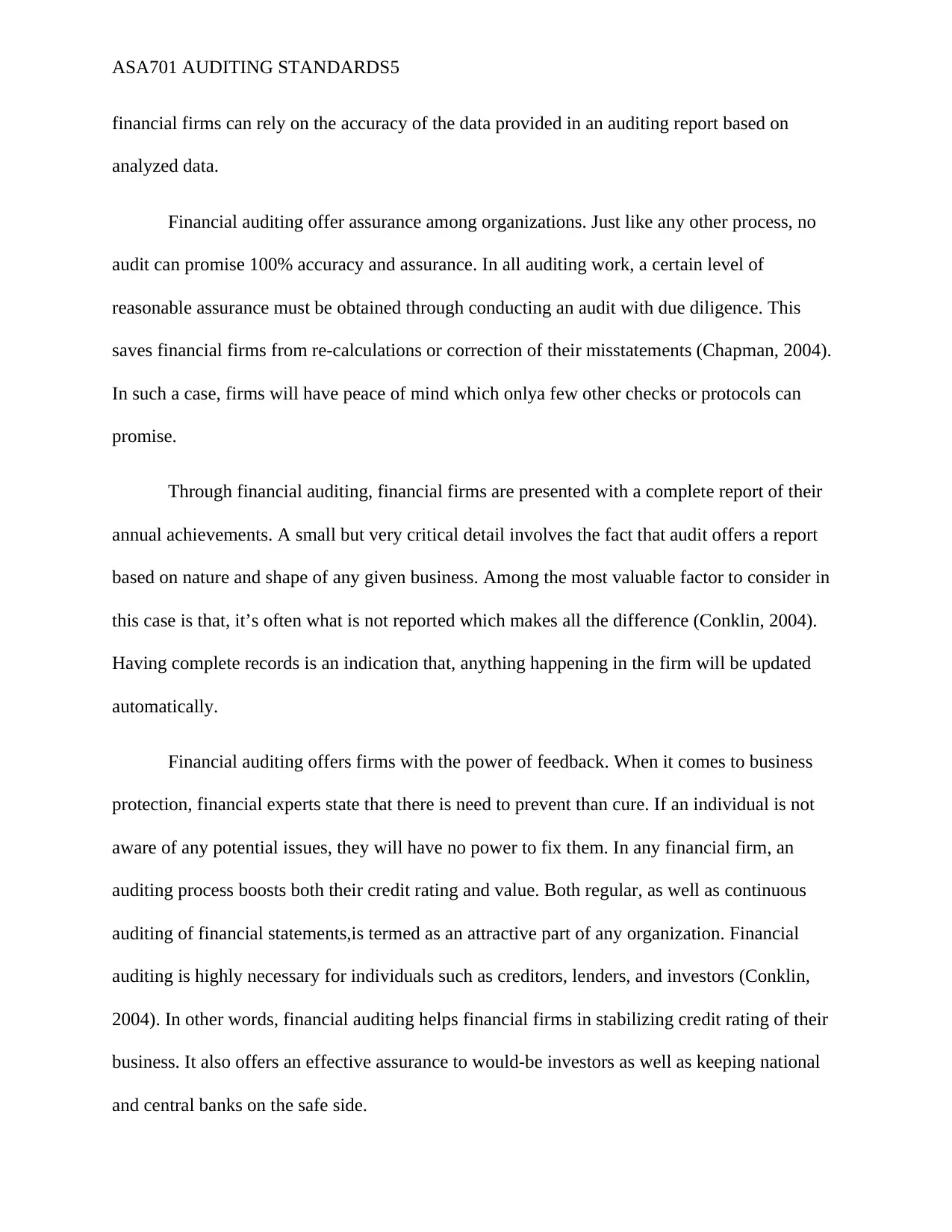
ASA701 AUDITING STANDARDS5
financial firms can rely on the accuracy of the data provided in an auditing report based on
analyzed data.
Financial auditing offer assurance among organizations. Just like any other process, no
audit can promise 100% accuracy and assurance. In all auditing work, a certain level of
reasonable assurance must be obtained through conducting an audit with due diligence. This
saves financial firms from re-calculations or correction of their misstatements (Chapman, 2004).
In such a case, firms will have peace of mind which onlya few other checks or protocols can
promise.
Through financial auditing, financial firms are presented with a complete report of their
annual achievements. A small but very critical detail involves the fact that audit offers a report
based on nature and shape of any given business. Among the most valuable factor to consider in
this case is that, it’s often what is not reported which makes all the difference (Conklin, 2004).
Having complete records is an indication that, anything happening in the firm will be updated
automatically.
Financial auditing offers firms with the power of feedback. When it comes to business
protection, financial experts state that there is need to prevent than cure. If an individual is not
aware of any potential issues, they will have no power to fix them. In any financial firm, an
auditing process boosts both their credit rating and value. Both regular, as well as continuous
auditing of financial statements,is termed as an attractive part of any organization. Financial
auditing is highly necessary for individuals such as creditors, lenders, and investors (Conklin,
2004). In other words, financial auditing helps financial firms in stabilizing credit rating of their
business. It also offers an effective assurance to would-be investors as well as keeping national
and central banks on the safe side.
financial firms can rely on the accuracy of the data provided in an auditing report based on
analyzed data.
Financial auditing offer assurance among organizations. Just like any other process, no
audit can promise 100% accuracy and assurance. In all auditing work, a certain level of
reasonable assurance must be obtained through conducting an audit with due diligence. This
saves financial firms from re-calculations or correction of their misstatements (Chapman, 2004).
In such a case, firms will have peace of mind which onlya few other checks or protocols can
promise.
Through financial auditing, financial firms are presented with a complete report of their
annual achievements. A small but very critical detail involves the fact that audit offers a report
based on nature and shape of any given business. Among the most valuable factor to consider in
this case is that, it’s often what is not reported which makes all the difference (Conklin, 2004).
Having complete records is an indication that, anything happening in the firm will be updated
automatically.
Financial auditing offers firms with the power of feedback. When it comes to business
protection, financial experts state that there is need to prevent than cure. If an individual is not
aware of any potential issues, they will have no power to fix them. In any financial firm, an
auditing process boosts both their credit rating and value. Both regular, as well as continuous
auditing of financial statements,is termed as an attractive part of any organization. Financial
auditing is highly necessary for individuals such as creditors, lenders, and investors (Conklin,
2004). In other words, financial auditing helps financial firms in stabilizing credit rating of their
business. It also offers an effective assurance to would-be investors as well as keeping national
and central banks on the safe side.
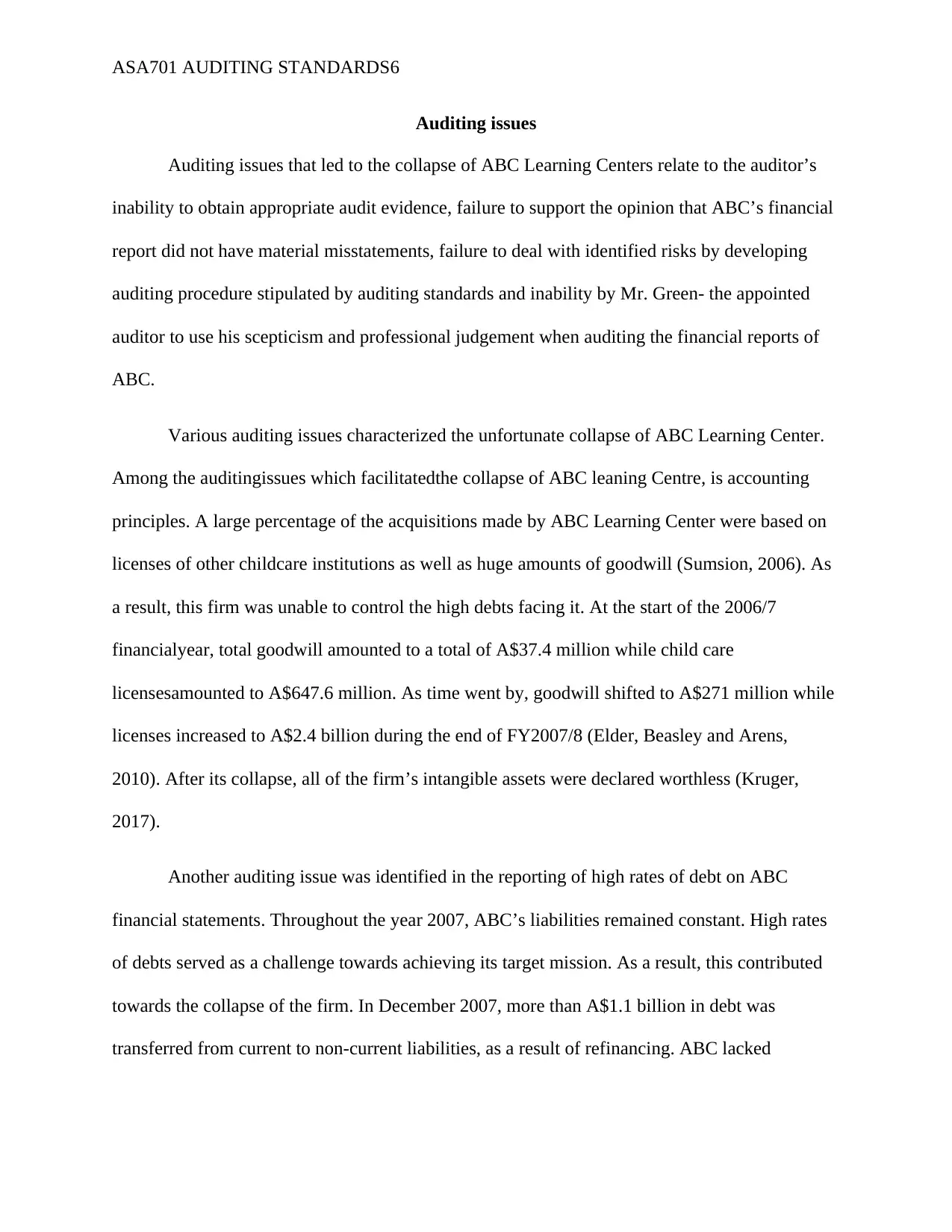
ASA701 AUDITING STANDARDS6
Auditing issues
Auditing issues that led to the collapse of ABC Learning Centers relate to the auditor’s
inability to obtain appropriate audit evidence, failure to support the opinion that ABC’s financial
report did not have material misstatements, failure to deal with identified risks by developing
auditing procedure stipulated by auditing standards and inability by Mr. Green- the appointed
auditor to use his scepticism and professional judgement when auditing the financial reports of
ABC.
Various auditing issues characterized the unfortunate collapse of ABC Learning Center.
Among the auditingissues which facilitatedthe collapse of ABC leaning Centre, is accounting
principles. A large percentage of the acquisitions made by ABC Learning Center were based on
licenses of other childcare institutions as well as huge amounts of goodwill (Sumsion, 2006). As
a result, this firm was unable to control the high debts facing it. At the start of the 2006/7
financialyear, total goodwill amounted to a total of A$37.4 million while child care
licensesamounted to A$647.6 million. As time went by, goodwill shifted to A$271 million while
licenses increased to A$2.4 billion during the end of FY2007/8 (Elder, Beasley and Arens,
2010). After its collapse, all of the firm’s intangible assets were declared worthless (Kruger,
2017).
Another auditing issue was identified in the reporting of high rates of debt on ABC
financial statements. Throughout the year 2007, ABC’s liabilities remained constant. High rates
of debts served as a challenge towards achieving its target mission. As a result, this contributed
towards the collapse of the firm. In December 2007, more than A$1.1 billion in debt was
transferred from current to non-current liabilities, as a result of refinancing. ABC lacked
Auditing issues
Auditing issues that led to the collapse of ABC Learning Centers relate to the auditor’s
inability to obtain appropriate audit evidence, failure to support the opinion that ABC’s financial
report did not have material misstatements, failure to deal with identified risks by developing
auditing procedure stipulated by auditing standards and inability by Mr. Green- the appointed
auditor to use his scepticism and professional judgement when auditing the financial reports of
ABC.
Various auditing issues characterized the unfortunate collapse of ABC Learning Center.
Among the auditingissues which facilitatedthe collapse of ABC leaning Centre, is accounting
principles. A large percentage of the acquisitions made by ABC Learning Center were based on
licenses of other childcare institutions as well as huge amounts of goodwill (Sumsion, 2006). As
a result, this firm was unable to control the high debts facing it. At the start of the 2006/7
financialyear, total goodwill amounted to a total of A$37.4 million while child care
licensesamounted to A$647.6 million. As time went by, goodwill shifted to A$271 million while
licenses increased to A$2.4 billion during the end of FY2007/8 (Elder, Beasley and Arens,
2010). After its collapse, all of the firm’s intangible assets were declared worthless (Kruger,
2017).
Another auditing issue was identified in the reporting of high rates of debt on ABC
financial statements. Throughout the year 2007, ABC’s liabilities remained constant. High rates
of debts served as a challenge towards achieving its target mission. As a result, this contributed
towards the collapse of the firm. In December 2007, more than A$1.1 billion in debt was
transferred from current to non-current liabilities, as a result of refinancing. ABC lacked
⊘ This is a preview!⊘
Do you want full access?
Subscribe today to unlock all pages.

Trusted by 1+ million students worldwide
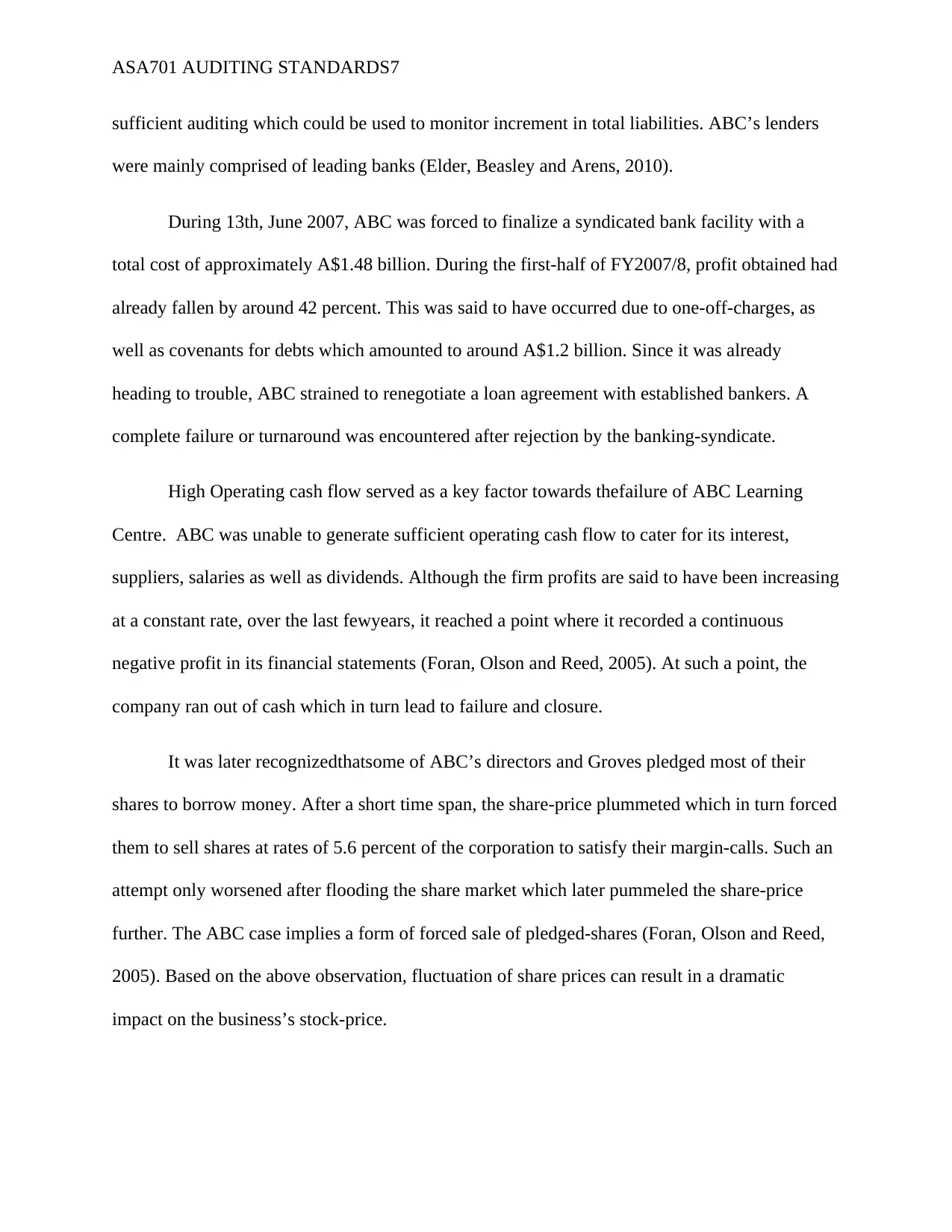
ASA701 AUDITING STANDARDS7
sufficient auditing which could be used to monitor increment in total liabilities. ABC’s lenders
were mainly comprised of leading banks (Elder, Beasley and Arens, 2010).
During 13th, June 2007, ABC was forced to finalize a syndicated bank facility with a
total cost of approximately A$1.48 billion. During the first-half of FY2007/8, profit obtained had
already fallen by around 42 percent. This was said to have occurred due to one-off-charges, as
well as covenants for debts which amounted to around A$1.2 billion. Since it was already
heading to trouble, ABC strained to renegotiate a loan agreement with established bankers. A
complete failure or turnaround was encountered after rejection by the banking-syndicate.
High Operating cash flow served as a key factor towards thefailure of ABC Learning
Centre. ABC was unable to generate sufficient operating cash flow to cater for its interest,
suppliers, salaries as well as dividends. Although the firm profits are said to have been increasing
at a constant rate, over the last fewyears, it reached a point where it recorded a continuous
negative profit in its financial statements (Foran, Olson and Reed, 2005). At such a point, the
company ran out of cash which in turn lead to failure and closure.
It was later recognizedthatsome of ABC’s directors and Groves pledged most of their
shares to borrow money. After a short time span, the share-price plummeted which in turn forced
them to sell shares at rates of 5.6 percent of the corporation to satisfy their margin-calls. Such an
attempt only worsened after flooding the share market which later pummeled the share-price
further. The ABC case implies a form of forced sale of pledged-shares (Foran, Olson and Reed,
2005). Based on the above observation, fluctuation of share prices can result in a dramatic
impact on the business’s stock-price.
sufficient auditing which could be used to monitor increment in total liabilities. ABC’s lenders
were mainly comprised of leading banks (Elder, Beasley and Arens, 2010).
During 13th, June 2007, ABC was forced to finalize a syndicated bank facility with a
total cost of approximately A$1.48 billion. During the first-half of FY2007/8, profit obtained had
already fallen by around 42 percent. This was said to have occurred due to one-off-charges, as
well as covenants for debts which amounted to around A$1.2 billion. Since it was already
heading to trouble, ABC strained to renegotiate a loan agreement with established bankers. A
complete failure or turnaround was encountered after rejection by the banking-syndicate.
High Operating cash flow served as a key factor towards thefailure of ABC Learning
Centre. ABC was unable to generate sufficient operating cash flow to cater for its interest,
suppliers, salaries as well as dividends. Although the firm profits are said to have been increasing
at a constant rate, over the last fewyears, it reached a point where it recorded a continuous
negative profit in its financial statements (Foran, Olson and Reed, 2005). At such a point, the
company ran out of cash which in turn lead to failure and closure.
It was later recognizedthatsome of ABC’s directors and Groves pledged most of their
shares to borrow money. After a short time span, the share-price plummeted which in turn forced
them to sell shares at rates of 5.6 percent of the corporation to satisfy their margin-calls. Such an
attempt only worsened after flooding the share market which later pummeled the share-price
further. The ABC case implies a form of forced sale of pledged-shares (Foran, Olson and Reed,
2005). Based on the above observation, fluctuation of share prices can result in a dramatic
impact on the business’s stock-price.
Paraphrase This Document
Need a fresh take? Get an instant paraphrase of this document with our AI Paraphraser
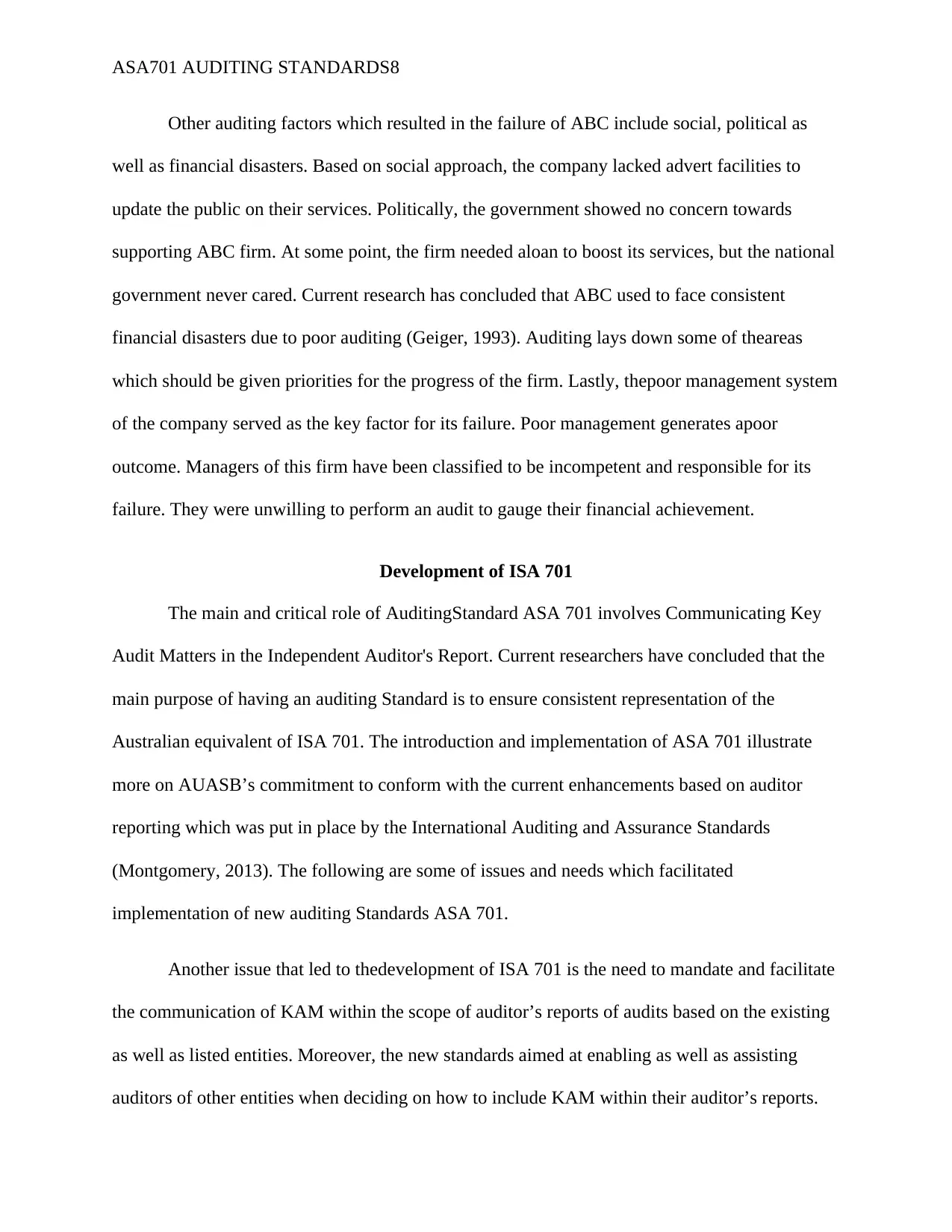
ASA701 AUDITING STANDARDS8
Other auditing factors which resulted in the failure of ABC include social, political as
well as financial disasters. Based on social approach, the company lacked advert facilities to
update the public on their services. Politically, the government showed no concern towards
supporting ABC firm. At some point, the firm needed aloan to boost its services, but the national
government never cared. Current research has concluded that ABC used to face consistent
financial disasters due to poor auditing (Geiger, 1993). Auditing lays down some of theareas
which should be given priorities for the progress of the firm. Lastly, thepoor management system
of the company served as the key factor for its failure. Poor management generates apoor
outcome. Managers of this firm have been classified to be incompetent and responsible for its
failure. They were unwilling to perform an audit to gauge their financial achievement.
Development of ISA 701
The main and critical role of AuditingStandard ASA 701 involves Communicating Key
Audit Matters in the Independent Auditor's Report. Current researchers have concluded that the
main purpose of having an auditing Standard is to ensure consistent representation of the
Australian equivalent of ISA 701. The introduction and implementation of ASA 701 illustrate
more on AUASB’s commitment to conform with the current enhancements based on auditor
reporting which was put in place by the International Auditing and Assurance Standards
(Montgomery, 2013). The following are some of issues and needs which facilitated
implementation of new auditing Standards ASA 701.
Another issue that led to thedevelopment of ISA 701 is the need to mandate and facilitate
the communication of KAM within the scope of auditor’s reports of audits based on the existing
as well as listed entities. Moreover, the new standards aimed at enabling as well as assisting
auditors of other entities when deciding on how to include KAM within their auditor’s reports.
Other auditing factors which resulted in the failure of ABC include social, political as
well as financial disasters. Based on social approach, the company lacked advert facilities to
update the public on their services. Politically, the government showed no concern towards
supporting ABC firm. At some point, the firm needed aloan to boost its services, but the national
government never cared. Current research has concluded that ABC used to face consistent
financial disasters due to poor auditing (Geiger, 1993). Auditing lays down some of theareas
which should be given priorities for the progress of the firm. Lastly, thepoor management system
of the company served as the key factor for its failure. Poor management generates apoor
outcome. Managers of this firm have been classified to be incompetent and responsible for its
failure. They were unwilling to perform an audit to gauge their financial achievement.
Development of ISA 701
The main and critical role of AuditingStandard ASA 701 involves Communicating Key
Audit Matters in the Independent Auditor's Report. Current researchers have concluded that the
main purpose of having an auditing Standard is to ensure consistent representation of the
Australian equivalent of ISA 701. The introduction and implementation of ASA 701 illustrate
more on AUASB’s commitment to conform with the current enhancements based on auditor
reporting which was put in place by the International Auditing and Assurance Standards
(Montgomery, 2013). The following are some of issues and needs which facilitated
implementation of new auditing Standards ASA 701.
Another issue that led to thedevelopment of ISA 701 is the need to mandate and facilitate
the communication of KAM within the scope of auditor’s reports of audits based on the existing
as well as listed entities. Moreover, the new standards aimed at enabling as well as assisting
auditors of other entities when deciding on how to include KAM within their auditor’s reports.
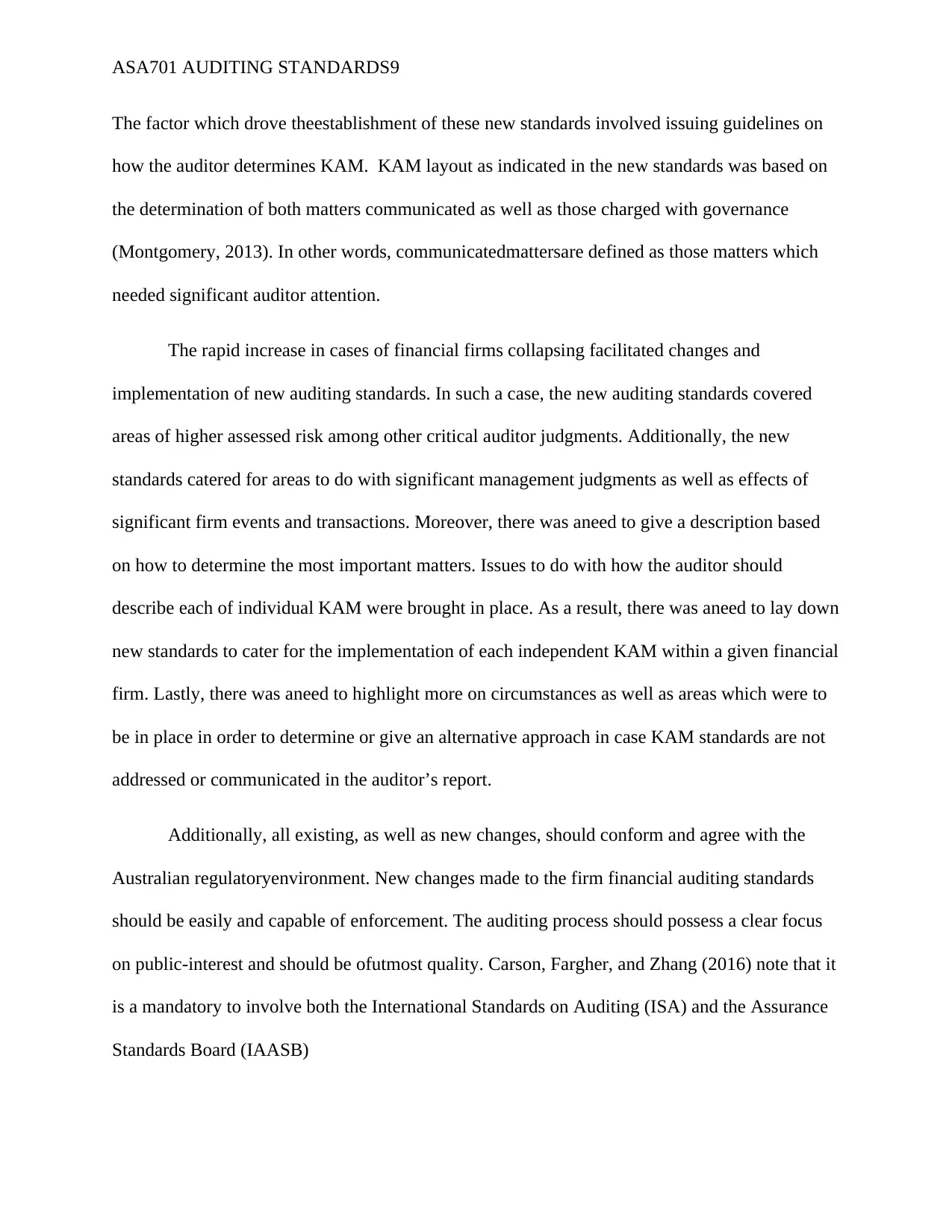
ASA701 AUDITING STANDARDS9
The factor which drove theestablishment of these new standards involved issuing guidelines on
how the auditor determines KAM. KAM layout as indicated in the new standards was based on
the determination of both matters communicated as well as those charged with governance
(Montgomery, 2013). In other words, communicatedmattersare defined as those matters which
needed significant auditor attention.
The rapid increase in cases of financial firms collapsing facilitated changes and
implementation of new auditing standards. In such a case, the new auditing standards covered
areas of higher assessed risk among other critical auditor judgments. Additionally, the new
standards catered for areas to do with significant management judgments as well as effects of
significant firm events and transactions. Moreover, there was aneed to give a description based
on how to determine the most important matters. Issues to do with how the auditor should
describe each of individual KAM were brought in place. As a result, there was aneed to lay down
new standards to cater for the implementation of each independent KAM within a given financial
firm. Lastly, there was aneed to highlight more on circumstances as well as areas which were to
be in place in order to determine or give an alternative approach in case KAM standards are not
addressed or communicated in the auditor’s report.
Additionally, all existing, as well as new changes, should conform and agree with the
Australian regulatoryenvironment. New changes made to the firm financial auditing standards
should be easily and capable of enforcement. The auditing process should possess a clear focus
on public-interest and should be ofutmost quality. Carson, Fargher, and Zhang (2016) note that it
is a mandatory to involve both the International Standards on Auditing (ISA) and the Assurance
Standards Board (IAASB)
The factor which drove theestablishment of these new standards involved issuing guidelines on
how the auditor determines KAM. KAM layout as indicated in the new standards was based on
the determination of both matters communicated as well as those charged with governance
(Montgomery, 2013). In other words, communicatedmattersare defined as those matters which
needed significant auditor attention.
The rapid increase in cases of financial firms collapsing facilitated changes and
implementation of new auditing standards. In such a case, the new auditing standards covered
areas of higher assessed risk among other critical auditor judgments. Additionally, the new
standards catered for areas to do with significant management judgments as well as effects of
significant firm events and transactions. Moreover, there was aneed to give a description based
on how to determine the most important matters. Issues to do with how the auditor should
describe each of individual KAM were brought in place. As a result, there was aneed to lay down
new standards to cater for the implementation of each independent KAM within a given financial
firm. Lastly, there was aneed to highlight more on circumstances as well as areas which were to
be in place in order to determine or give an alternative approach in case KAM standards are not
addressed or communicated in the auditor’s report.
Additionally, all existing, as well as new changes, should conform and agree with the
Australian regulatoryenvironment. New changes made to the firm financial auditing standards
should be easily and capable of enforcement. The auditing process should possess a clear focus
on public-interest and should be ofutmost quality. Carson, Fargher, and Zhang (2016) note that it
is a mandatory to involve both the International Standards on Auditing (ISA) and the Assurance
Standards Board (IAASB)
⊘ This is a preview!⊘
Do you want full access?
Subscribe today to unlock all pages.

Trusted by 1+ million students worldwide
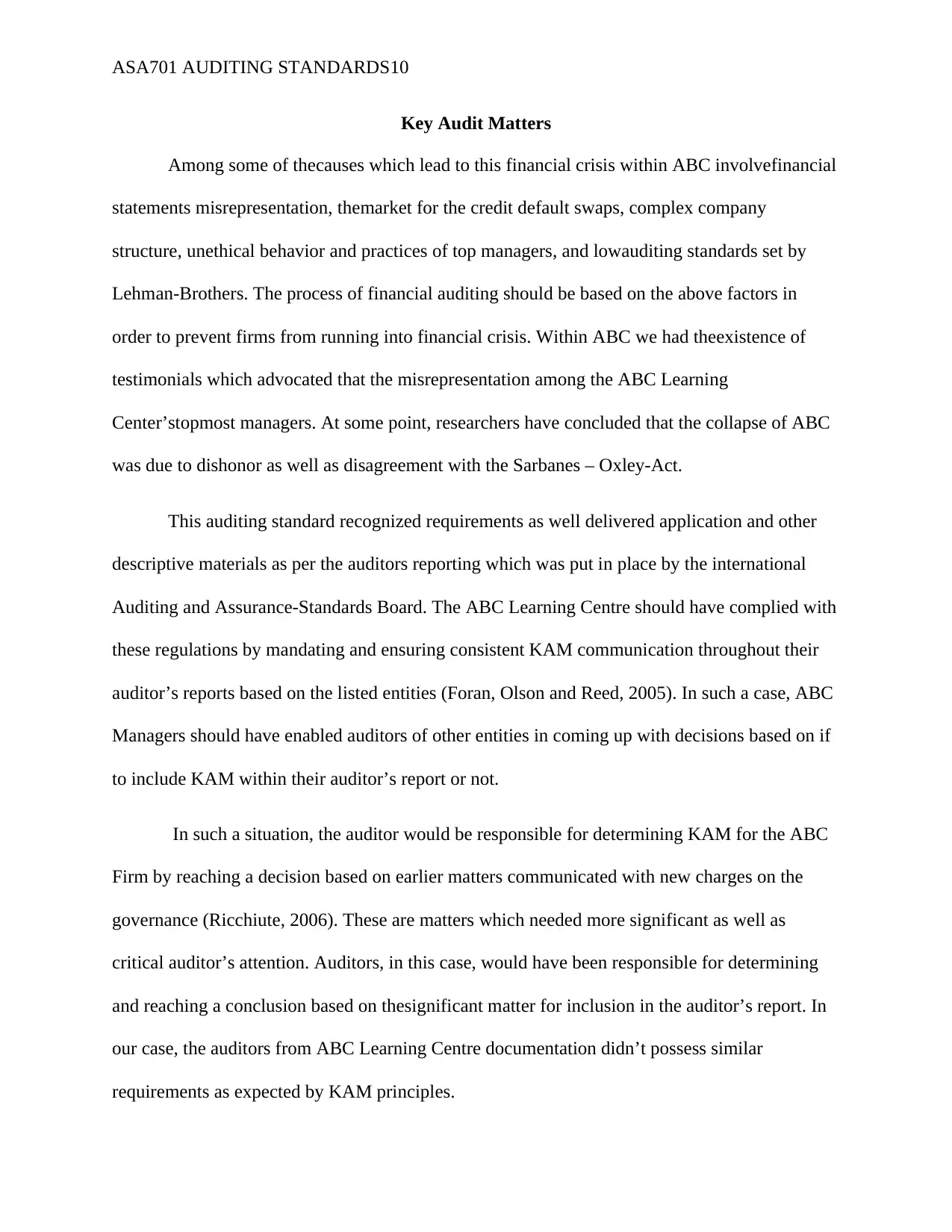
ASA701 AUDITING STANDARDS10
Key Audit Matters
Among some of thecauses which lead to this financial crisis within ABC involvefinancial
statements misrepresentation, themarket for the credit default swaps, complex company
structure, unethical behavior and practices of top managers, and lowauditing standards set by
Lehman-Brothers. The process of financial auditing should be based on the above factors in
order to prevent firms from running into financial crisis. Within ABC we had theexistence of
testimonials which advocated that the misrepresentation among the ABC Learning
Center’stopmost managers. At some point, researchers have concluded that the collapse of ABC
was due to dishonor as well as disagreement with the Sarbanes – Oxley-Act.
This auditing standard recognized requirements as well delivered application and other
descriptive materials as per the auditors reporting which was put in place by the international
Auditing and Assurance-Standards Board. The ABC Learning Centre should have complied with
these regulations by mandating and ensuring consistent KAM communication throughout their
auditor’s reports based on the listed entities (Foran, Olson and Reed, 2005). In such a case, ABC
Managers should have enabled auditors of other entities in coming up with decisions based on if
to include KAM within their auditor’s report or not.
In such a situation, the auditor would be responsible for determining KAM for the ABC
Firm by reaching a decision based on earlier matters communicated with new charges on the
governance (Ricchiute, 2006). These are matters which needed more significant as well as
critical auditor’s attention. Auditors, in this case, would have been responsible for determining
and reaching a conclusion based on thesignificant matter for inclusion in the auditor’s report. In
our case, the auditors from ABC Learning Centre documentation didn’t possess similar
requirements as expected by KAM principles.
Key Audit Matters
Among some of thecauses which lead to this financial crisis within ABC involvefinancial
statements misrepresentation, themarket for the credit default swaps, complex company
structure, unethical behavior and practices of top managers, and lowauditing standards set by
Lehman-Brothers. The process of financial auditing should be based on the above factors in
order to prevent firms from running into financial crisis. Within ABC we had theexistence of
testimonials which advocated that the misrepresentation among the ABC Learning
Center’stopmost managers. At some point, researchers have concluded that the collapse of ABC
was due to dishonor as well as disagreement with the Sarbanes – Oxley-Act.
This auditing standard recognized requirements as well delivered application and other
descriptive materials as per the auditors reporting which was put in place by the international
Auditing and Assurance-Standards Board. The ABC Learning Centre should have complied with
these regulations by mandating and ensuring consistent KAM communication throughout their
auditor’s reports based on the listed entities (Foran, Olson and Reed, 2005). In such a case, ABC
Managers should have enabled auditors of other entities in coming up with decisions based on if
to include KAM within their auditor’s report or not.
In such a situation, the auditor would be responsible for determining KAM for the ABC
Firm by reaching a decision based on earlier matters communicated with new charges on the
governance (Ricchiute, 2006). These are matters which needed more significant as well as
critical auditor’s attention. Auditors, in this case, would have been responsible for determining
and reaching a conclusion based on thesignificant matter for inclusion in the auditor’s report. In
our case, the auditors from ABC Learning Centre documentation didn’t possess similar
requirements as expected by KAM principles.
Paraphrase This Document
Need a fresh take? Get an instant paraphrase of this document with our AI Paraphraser
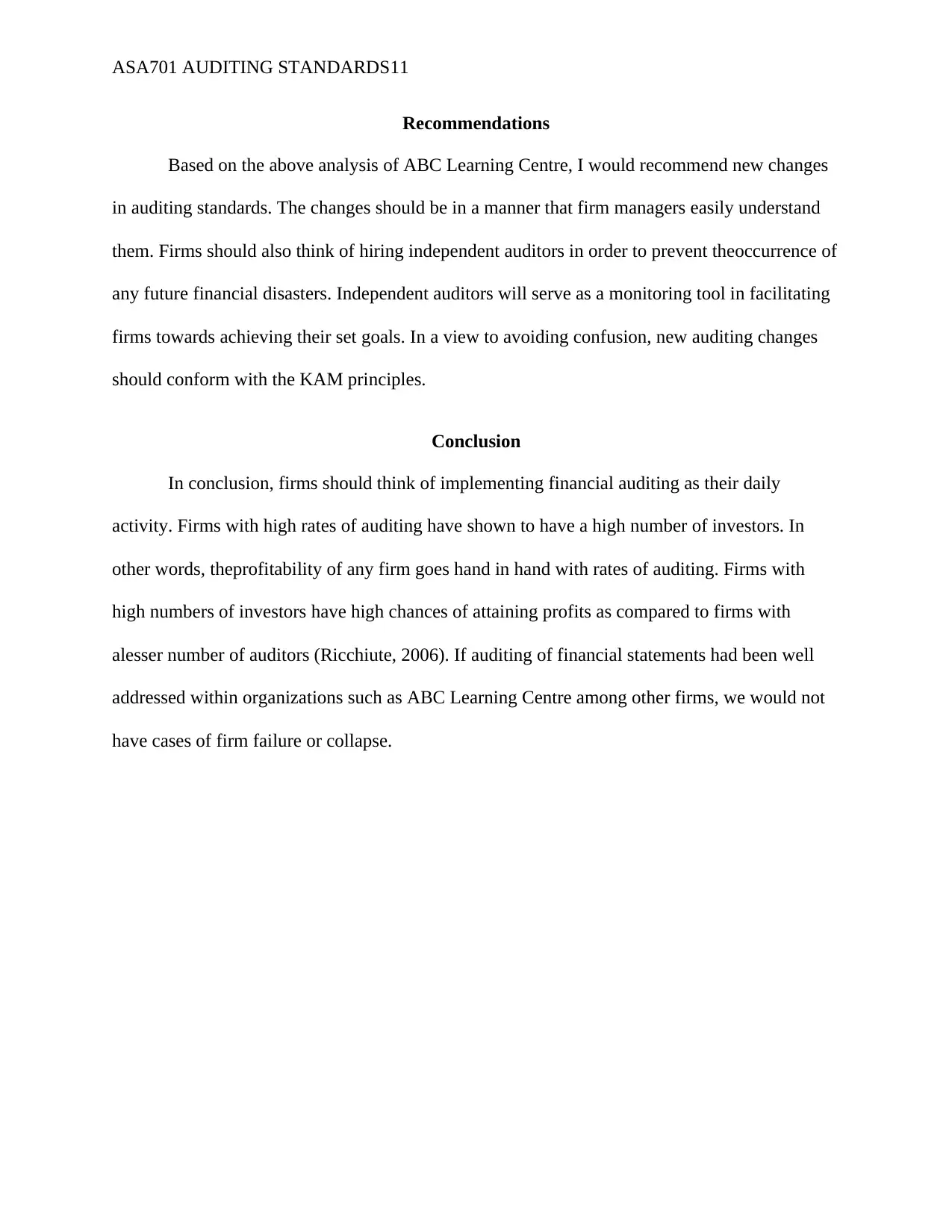
ASA701 AUDITING STANDARDS11
Recommendations
Based on the above analysis of ABC Learning Centre, I would recommend new changes
in auditing standards. The changes should be in a manner that firm managers easily understand
them. Firms should also think of hiring independent auditors in order to prevent theoccurrence of
any future financial disasters. Independent auditors will serve as a monitoring tool in facilitating
firms towards achieving their set goals. In a view to avoiding confusion, new auditing changes
should conform with the KAM principles.
Conclusion
In conclusion, firms should think of implementing financial auditing as their daily
activity. Firms with high rates of auditing have shown to have a high number of investors. In
other words, theprofitability of any firm goes hand in hand with rates of auditing. Firms with
high numbers of investors have high chances of attaining profits as compared to firms with
alesser number of auditors (Ricchiute, 2006). If auditing of financial statements had been well
addressed within organizations such as ABC Learning Centre among other firms, we would not
have cases of firm failure or collapse.
Recommendations
Based on the above analysis of ABC Learning Centre, I would recommend new changes
in auditing standards. The changes should be in a manner that firm managers easily understand
them. Firms should also think of hiring independent auditors in order to prevent theoccurrence of
any future financial disasters. Independent auditors will serve as a monitoring tool in facilitating
firms towards achieving their set goals. In a view to avoiding confusion, new auditing changes
should conform with the KAM principles.
Conclusion
In conclusion, firms should think of implementing financial auditing as their daily
activity. Firms with high rates of auditing have shown to have a high number of investors. In
other words, theprofitability of any firm goes hand in hand with rates of auditing. Firms with
high numbers of investors have high chances of attaining profits as compared to firms with
alesser number of auditors (Ricchiute, 2006). If auditing of financial statements had been well
addressed within organizations such as ABC Learning Centre among other firms, we would not
have cases of firm failure or collapse.
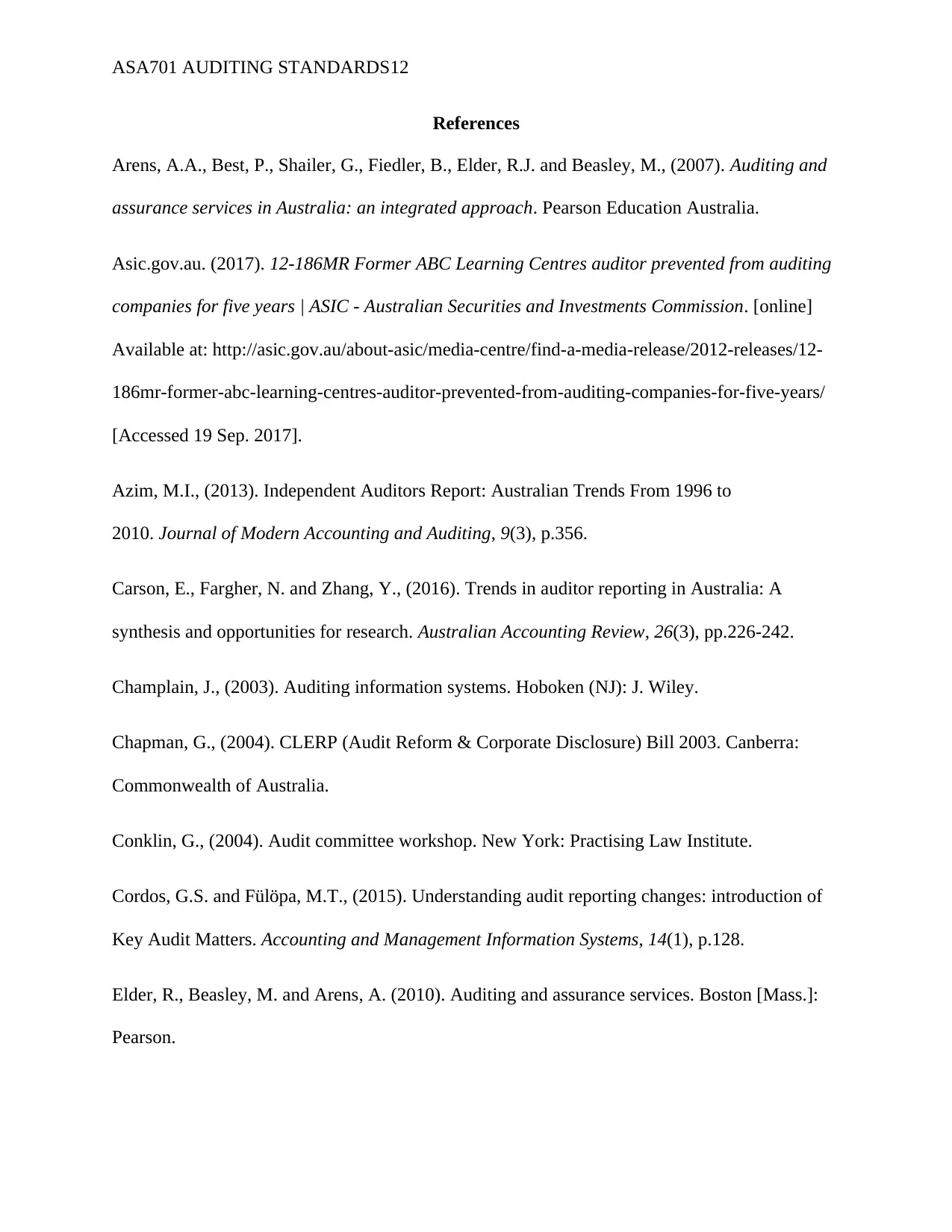
ASA701 AUDITING STANDARDS12
References
Arens, A.A., Best, P., Shailer, G., Fiedler, B., Elder, R.J. and Beasley, M., (2007). Auditing and
assurance services in Australia: an integrated approach. Pearson Education Australia.
Asic.gov.au. (2017). 12-186MR Former ABC Learning Centres auditor prevented from auditing
companies for five years | ASIC - Australian Securities and Investments Commission. [online]
Available at: http://asic.gov.au/about-asic/media-centre/find-a-media-release/2012-releases/12-
186mr-former-abc-learning-centres-auditor-prevented-from-auditing-companies-for-five-years/
[Accessed 19 Sep. 2017].
Azim, M.I., (2013). Independent Auditors Report: Australian Trends From 1996 to
2010. Journal of Modern Accounting and Auditing, 9(3), p.356.
Carson, E., Fargher, N. and Zhang, Y., (2016). Trends in auditor reporting in Australia: A
synthesis and opportunities for research. Australian Accounting Review, 26(3), pp.226-242.
Champlain, J., (2003). Auditing information systems. Hoboken (NJ): J. Wiley.
Chapman, G., (2004). CLERP (Audit Reform & Corporate Disclosure) Bill 2003. Canberra:
Commonwealth of Australia.
Conklin, G., (2004). Audit committee workshop. New York: Practising Law Institute.
Cordos, G.S. and Fülöpa, M.T., (2015). Understanding audit reporting changes: introduction of
Key Audit Matters. Accounting and Management Information Systems, 14(1), p.128.
Elder, R., Beasley, M. and Arens, A. (2010). Auditing and assurance services. Boston [Mass.]:
Pearson.
References
Arens, A.A., Best, P., Shailer, G., Fiedler, B., Elder, R.J. and Beasley, M., (2007). Auditing and
assurance services in Australia: an integrated approach. Pearson Education Australia.
Asic.gov.au. (2017). 12-186MR Former ABC Learning Centres auditor prevented from auditing
companies for five years | ASIC - Australian Securities and Investments Commission. [online]
Available at: http://asic.gov.au/about-asic/media-centre/find-a-media-release/2012-releases/12-
186mr-former-abc-learning-centres-auditor-prevented-from-auditing-companies-for-five-years/
[Accessed 19 Sep. 2017].
Azim, M.I., (2013). Independent Auditors Report: Australian Trends From 1996 to
2010. Journal of Modern Accounting and Auditing, 9(3), p.356.
Carson, E., Fargher, N. and Zhang, Y., (2016). Trends in auditor reporting in Australia: A
synthesis and opportunities for research. Australian Accounting Review, 26(3), pp.226-242.
Champlain, J., (2003). Auditing information systems. Hoboken (NJ): J. Wiley.
Chapman, G., (2004). CLERP (Audit Reform & Corporate Disclosure) Bill 2003. Canberra:
Commonwealth of Australia.
Conklin, G., (2004). Audit committee workshop. New York: Practising Law Institute.
Cordos, G.S. and Fülöpa, M.T., (2015). Understanding audit reporting changes: introduction of
Key Audit Matters. Accounting and Management Information Systems, 14(1), p.128.
Elder, R., Beasley, M. and Arens, A. (2010). Auditing and assurance services. Boston [Mass.]:
Pearson.
⊘ This is a preview!⊘
Do you want full access?
Subscribe today to unlock all pages.

Trusted by 1+ million students worldwide
1 out of 14
Related Documents
Your All-in-One AI-Powered Toolkit for Academic Success.
+13062052269
info@desklib.com
Available 24*7 on WhatsApp / Email
![[object Object]](/_next/static/media/star-bottom.7253800d.svg)
Unlock your academic potential
Copyright © 2020–2025 A2Z Services. All Rights Reserved. Developed and managed by ZUCOL.





